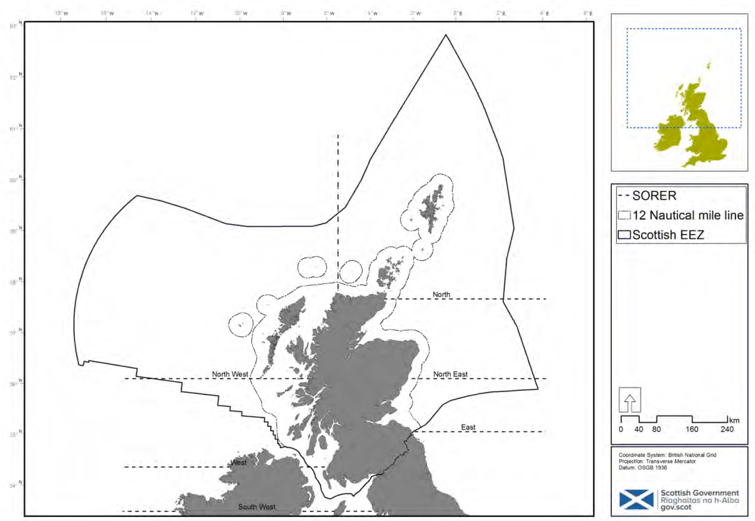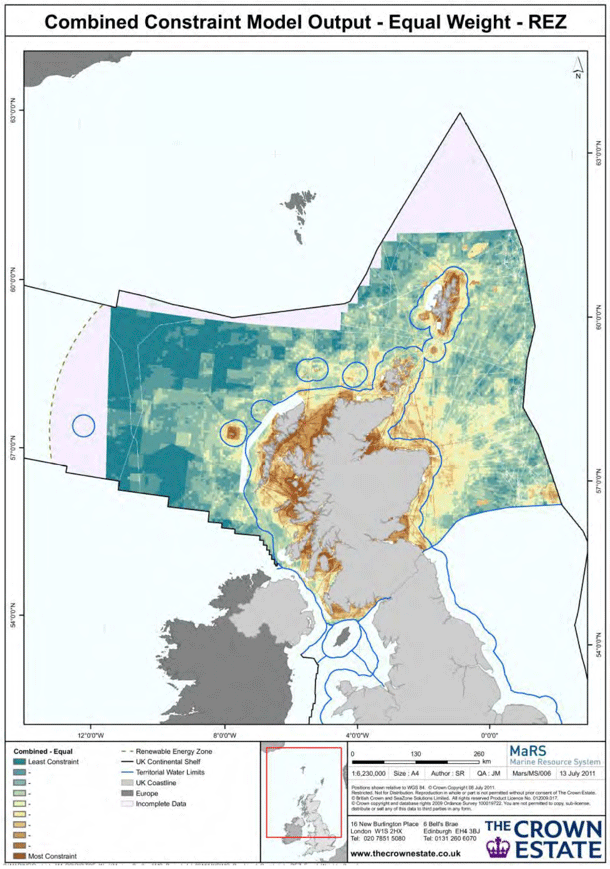Search areas for offshore wind energy: scoping study
Scoping study about identifying areas of search to potentially be developed into draft plan options for offshore wind energy in Scottish waters.
1. Introduction
1.1 Potential for offshore wind in Scotland
Within Scottish Waters (includes territorial waters and Exclusive Economic zone ( EEZ)) there exists a great deal of potential offshore wind resources that could be used to generate energy using offshore wind turbines. Maximising this offshore renewable resource requires the identification of potential development locations and careful selection of areas through a scientific scoping process. This process must take into account the many uses of the sea that potential new developments may interact with. Interactions can be industrial, cultural or environmental.
This study uses Geographic Information System ( GIS) data to visualise the many uses of Scottish waters, combine them into a single output and identify areas where potential exists to recommend further development. The selected areas are within the Scottish Offshore Renewable Energy Regions ( SORER). Some areas can cover more than one SORER. Section 4 contextualises the identified areas at a broad scale (east, west and north coasts, Orkney and Shetland) and details which SORER they are within. Figure 2 shows the SORER limits.
Figure 2: SORER limits. © Crown copyright and database rights (2018) OS (100024655).

The activities and existing infrastructure included in this study have been categorised into two groups: those where there is no compatibility with offshore development and those that show a range of constraint towards offshore development. These two groups were each represented using GIS outputs.
The study does not seek to identify specific areas for development but to take the first step in the sectoral planning process by identifying broad areas within which it would be logistically realistic to host development of new commercial offshore wind arrays. The Areas of Search ( AoS) shown are not proposed as sites to be developed in their entirety. They provide the starting point from which optimum locations for offshore wind energy production can be identified and Plan Options produced.
Currently the majority of offshore wind farms have been built using conventional fixed bottom substructure technology. The maximum depth considered economically and technically feasible for these to be installed is approximately up to 60 m of depth (The Carbon Trust, 2015). This depth requirement significantly limits the amount of seabed space that can be exploited. New technology like floating wind turbines attached to the seabed by chains and anchors can potentially open up new areas of sea as they are theoretically not limited by depth.
The full range of water depths have been considered in this study. The depth data used was measured using the lowest astronomical tide as its reference. The depths included range from shore depths to the maximum depths within Scottish waters, At present the maximum depth considered for offshore deployment is 800 m as expressed by Statoil in reference to their Hywind technology (Statoil, 2015).Construction and deployment prices of floating foundations may eventually compete with those of fixed bottom technologies (The Carbon Trust, 2015), if floating wind sees a similarly rapid cost reduction to that which has taken placed in the fixed foundation wind industry.
The large scale potential for offshore wind has been investigated recently by BVG Associates (2017). This work involved multi-criteria analysis based principally on economically attractive potential using levelised cost of energy as the main metric. The study focused on areas that can be expected to allow construction and operation under an acceptably profitable threshold. The North Sea and parts of the west and north coast were identified as having potential for wind technology to be used to exploit wind resources in deeper water. Floating wind technologies were included as a possible technical solution.
The BVG Associates (2017) report recognises Scotland's offshore wind potential from the economic perspective. This scoping report aims to identify it from the planning perspective.
1.2 The Scottish Sectoral plan for offshore wind: Scoping study 2011
In 2011 Marine Scotland published a Scoping Study for Offshore Wind Farm Development in Scottish Waters (Davies and Watret, 2011) that applied spatial multi-criteria analysis to investigate the most suitable locations for offshore wind farms out to 200 nautical miles ( NM). This scoping study was undertaken in conjunction with the Crown Estate ( TCE) using their Marine Resource System ( MaRS) asset management tool. The scoping study used a suite of GIS layers provided by Marine Scotland ( MS) and TCE.
Three types of output model were created:
- A technical model, this described spatially the resource to be exploited and the technical feasibility to do so
- An exclusion model which collected the features that were deemed incompatible with offshore wind development and removed their known footprint from the output
- A constraint model which gave the combined degree of interaction to be encountered and was generated by combining three themed restriction models
The large number of layers of spatial information that were used for the combined constraint model output benefited from being grouped into three themes based on their conceptual similarity: environmental, industrial and socio-economic. This combination of the restriction, exclusion and technical output models was the basis from which the spatial selection of AoS were made. Figure 3 shows the combined constraint output taken forward to be used to select the most suitable areas.
Figure 3: Results of the MaRS multi-criteria analysis study for the offshore wind scoping study of 2011. Combined output from the three themes (environmental, industrial and socio-cultural) weighted equally for the three themes. © Crown Copyright 2011.

By identifying the broad scale locations that present minimised constraint a set of broad AoS were drawn that brought together the most suitable areas These AoS provided the starting point for the consultation and assessment process which were used to refine these areas in to Draft Plan Options. Scottish Ministers' consulted on these options in 2013
1.3 Updating the offshore wind scoping study for 2018
The processes undertaken to create the new AoS for offshore wind in Scottish waters are described below. A feature of the sectoral marine planning process is the integrated opportunity provided through consultation that allows new or more recent data to be considered at these early stages. This document contains an account of the scientific modelling process undertaken and information taken into account in order to inform the identification of potential plan options.
The technological changes in the offshore wind industry now allow further offshore developments to be considered. Floating technology allows the potential to deploy in areas previously considered unsuitable on engineering grounds. The first step to identify new AoS locations is to apply multi-criteria analysis using relevant spatial data layers and considerations. This study collates 20 data sets and uses them to investigate potential areas of opportunity and constraint. For guidance and confirmation on what aspects were more relevant to identify the Pre-statutory Consultation – Draft Analysis Report (Marine Scotland, 2013b) was referred to and the more recurring themes and issues were included. This document summarised the discussions and issues raised by consultees during the pre-statutory consultation period on the sectoral marine plans for offshore wind, wave and tidal that took place in 2013.
The three themes applied in Davies & Watret (2011) are also used in this analysis as they are helpful for describing sets of layers collectively, hence the groupings of data types into industrial, environmental or socio-cultural continues in this work. To these the technical theme, which describes the resource to be exploited and the suitable conditions for development, has been added also.
Most of the layers applied in this study were also included in Davies & Watret (2011). Some of the layers used have been updated since then and some improved layers have been added. Similar relative weighting values as the scoping study of 2011 have been applied to this analysis as many of the considerations remain pertinent. Table 1 provides a comparison of the layers and weightings from Davies & Watret (2011) and those used in this study.
Data improvements to the layers used in Davies & Watret (2011) allows for a more spatially detailed analysis and a better representation of where offshore wind development opportunity exists. Examples of new and improved GIS layers are those that describe: coastal tourism density, shipping density, and combined fishing activity.
Contact
There is a problem
Thanks for your feedback